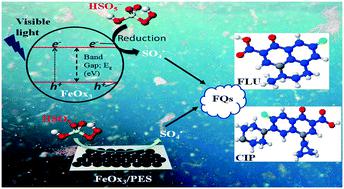当前位置:
X-MOL 学术
›
Environ. Sci.: Nano
›
论文详情
Our official English website, www.x-mol.net, welcomes your feedback! (Note: you will need to create a separate account there.)
Nano-sized iron oxides supported on polyester textile to remove fluoroquinolones in hospital wastewater
Environmental Science: Nano ( IF 7.3 ) Pub Date : 2020-06-11 , DOI: 10.1039/d0en00261e Gnougon Nina Coulibaly 1, 2, 3, 4, 5 , Sami Rtimi 6, 7, 8, 9 , Aymen Amin Assadi 1, 2, 3, 4, 5 , Khalil Hanna 1, 2, 3, 4, 5
Environmental Science: Nano ( IF 7.3 ) Pub Date : 2020-06-11 , DOI: 10.1039/d0en00261e Gnougon Nina Coulibaly 1, 2, 3, 4, 5 , Sami Rtimi 6, 7, 8, 9 , Aymen Amin Assadi 1, 2, 3, 4, 5 , Khalil Hanna 1, 2, 3, 4, 5
Affiliation

|
In this study, we examined the removal kinetics of two fluoroquinolones (FQs), flumequine (FLU) and ciprofloxacin (CIP), in synthetic wastewater (SWW) and real hospital wastewater (RHW) using FeOx thin films, peroxymonosulfate (PMS) and visible light. Nano-sized iron oxides (FeOx) supported on polyester textile (PES) were synthesized by a novel high-power impulse magnetron sputtering (HiPIMS) method. The O2/Ar ratio is an important factor to tune Fe oxidation, which controls the composition of the thin film and thus the capability of the resulting FeOx for PMS activation. Based on scavenging experiments, sulfate radicals were shown to be predominantly involved in the heterogeneous oxidation reaction. Competitive effects with reactive species could explain the lower degradation rate constants in mixtures relative to those in single systems. In contrast to chlorides, organic matter, sulfates and phosphates commonly found in RHW dramatically decreased the removal performance of both target compounds, FLU and CIP. However, increasing the PMS concentration to 3 mM improved considerably the degradation and mineralization, even in real wastewater. The good stability and reusability of the FeOx/PES material have been confirmed in hospital wastewater over five successive oxidation cycles.
中文翻译:

负载在聚酯纺织品上的纳米级氧化铁可去除医院废水中的氟喹诺酮类
在这项研究中,我们使用FeOx薄膜,过氧一硫酸盐(PMS)和可见光检查了合成废水(SWW)和实际医院废水(RHW)中两种氟喹诺酮(FQs),氟美花碱(FLU)和环丙沙星(CIP)的去除动力学。光。通过一种新型的高功率脉冲磁控溅射(HiPIMS)方法合成了负载在聚酯织物(PES)上的纳米级氧化铁(FeOx)。O 2/ Ar比是调节Fe氧化的重要因素,Fe氧化控制薄膜的组成,从而控制所得FeOx用于PMS活化的能力。根据清除实验,硫酸根自由基主要参与了异相氧化反应。与反应物种的竞争效应可以解释混合物中降解速率常数相对于单个系统中较低。与氯化物不同,RHW中常见的有机物,硫酸盐和磷酸盐大大降低了目标化合物FLU和CIP的去除性能。但是,即使在实际废水中,将PMS浓度提高到3 mM也可以显着改善降解和矿化作用。
更新日期:2020-07-16
中文翻译:

负载在聚酯纺织品上的纳米级氧化铁可去除医院废水中的氟喹诺酮类
在这项研究中,我们使用FeOx薄膜,过氧一硫酸盐(PMS)和可见光检查了合成废水(SWW)和实际医院废水(RHW)中两种氟喹诺酮(FQs),氟美花碱(FLU)和环丙沙星(CIP)的去除动力学。光。通过一种新型的高功率脉冲磁控溅射(HiPIMS)方法合成了负载在聚酯织物(PES)上的纳米级氧化铁(FeOx)。O 2/ Ar比是调节Fe氧化的重要因素,Fe氧化控制薄膜的组成,从而控制所得FeOx用于PMS活化的能力。根据清除实验,硫酸根自由基主要参与了异相氧化反应。与反应物种的竞争效应可以解释混合物中降解速率常数相对于单个系统中较低。与氯化物不同,RHW中常见的有机物,硫酸盐和磷酸盐大大降低了目标化合物FLU和CIP的去除性能。但是,即使在实际废水中,将PMS浓度提高到3 mM也可以显着改善降解和矿化作用。



























 京公网安备 11010802027423号
京公网安备 11010802027423号